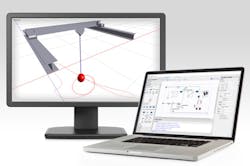Digital twins are one of the more intriguing capabilities unleashed by the digitization of industrial data. As described in a recent Automation World feature, digital twins can “contain a massive amount of data about existing machines, down to the component level, [enabling] a virtualized representation of production equipment in a factory.”
These virtualized machines can be scaled to represent entire factory lines allowing them to play a key role in helping manufacturers model different scenarios to optimize energy efficiency, improve production operations, visualize the results of different machinery arrays and even commission equipment.
Digital twin technology can also be used for machine development—a capability targeted by automation technology supplier B&R with the integration of MapleSoft’s MapleSim Connector into its B&R Automation Studio software. B&R’s Automation Studio is an integrated software development tool that enables the configuration of all components in an automated system—controllers, drives, communications, and visualization—in one environment.MapleSim creates a dynamic model of the machine based on CAD data in STEP format. All forces and torques are modeled in the software, allowing the model to then be used as a digital twin for component sizing.
B&R’s integration of the MapleSim Connector allows B&R customers to use the MapleSim tool to avoid design errors during machine development. In its release announcing the MapleSim Connector integration, B&R says the physical model produced by the MapleSim tool can also be used as a functional mock up unit for virtual commissioning of the machine software in Automation Studio.
The MapleSim Connector offers two export functions for use of digital twins in the machine development process. The first of these functions allows for the exporting of simulation data to optimize the sizing of servo drives, motors and gearboxes using tools like ServoSoft. The other export function allows for models built in MapleSim to be exported as an FMI file with the CAD data included.
Beyond simulation use in Automation Studio, models built in MapleSim can be transferred directly to the B&R control hardware. B&R notes that this capability allows for “hardware-in-the-loop simulation, where the machine's behavior is emulated in real time to create a controlled environment where the machine software can be tested safely. In this environment, all control parameters can be manipulated and the temperature behavior of the drive can be simulated. The behavior of the digital twin is visualized live in B&R Scene Viewer.”


